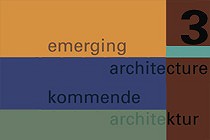
|
Emerging Architecture 3 - Kommende Architektur 3 Beyond Architainment Location: Architekturzentrum Wien - Old hall Exhibition: 21 November 2002 - 10 March 2003 Opening Hours: Daily 10:00 am - 7:00 pm, Wed until 9:00 pm Opening: Wednesday 20 November 2002, 7pm weichlbauer / ortis mauritzener hauptstraße 3 a - 8130 frohnleiten austria phone +43-3126-4510 fax +43-3126-4510 reinholdweichlbauer@aon.at, ortis@utanet.at reinhold weichlbauer born in bruck/mur, styria, in 1962; secondary school of technology (htbla) 1977 - 1982, graz tu, awarded diploma in 1989 and civil engineer's license in 1994; teaching assignment at graz htbla since 1998. albert josef ortis born in graz in 1961; htbla 1976 - 1981, graz tu, awarded diploma in 1990 and civil engineer's license in 1994; assistant at graz tu 1990 - 1996. buildings, projects (select): 1991 - 2001: austria 1000 terminal, vienna; residential fracture, neudörfl, burgenland; residential tool, frohnleiten; residential settlement, st.bartholomä; consulting office anatomy, st.oswald; family shelves, frohnleiten; repacking, residential building, st.lorenzen; residential transformation, deutschlandsberg; residential DNA, gratkorn; system kindergarten, peggau; school diagram, stainach; all in styria. urban heartbeat; tool modulation; villa game; residential irritation; w#plus; art block, iron house; office implant; all in graz. architecture reparation, liverpool, great britain; dwelling mobility, giubiasco, switzerland; energy game house, tokyo; hybrid structure, tallinn, estonia. ambivalence advances in general, the architecture scene has banally acknowledged postmodernity as a cultural condition. weichlbauer / ortis are among the few planners in austria who attempt to practice the postmodern principle of ambivalence as a form of living and an operational method at today's intellectual level. they are up to (virtually) all the tricks of chaos theory, fuzzy logic, the theories of data processing, science and architecture. however, they consciously beware of obvious extremes: the extreme to turn such instruments against its inherent logic by applying them in terms of conventional modernity in order to create "innovative" forms or new "styles"; or the other extreme that would see subjective decision-making or intuition fully eliminated from form-finding processes. weichlbauer / ortis lead double-encoded lives in which one directs a contracting company while the other teaches at a building school, to join forces in a parallel existence and be able to "afford" outings into conceptional architecture. according to their understanding, the knowledge of "fractally determined space" is no real urge to seek inventions of "fractal" forms, but rather a qualification for new, open insights into and arrangements of influence factors and levels of reality. on the other hand, they employ computer programs and random generators at the beginning and in between planning steps. their objective is to fade out subjective preferences and internalized schematisms at the very root of design decisions, to let their own interpretation intervene in the mechanically triggered process, carrying on in a declared and selectively intuitive fashion. [...] |
 |
|
|
|
Current Preview Permanent Exhibition Emerging Architecture 3 - Kommende Architektur 3 The 10 Teams * Feyferlik / Fritzer * AllesWirdGut * Holz Box Tirol * pool * one room huber / meinhart * PPAG * RATAPLAN * riccione * franz sam * weichlbauer / ortis Press Release: Emerging Architecture 3 - Kommende Architektur Gallery: Emerging Architecture 3 - Kommende Architektur 3 E-Shop Products: DVD: Emerging Architecture 3 - Kommende Architektur 3 Book: Emerging Architecture 3 / Kommende Architektur 3 Information: Ines Purtauf Tel.: +43 (1) 522 31 15 - 25 Fax: +43 (1) 522 31 17 Email: purtauf@azw.at |
| © Architekturzentrum Wien 2025 |
||



